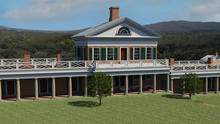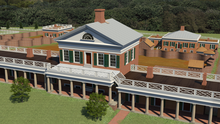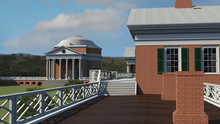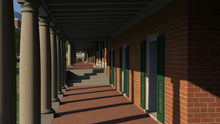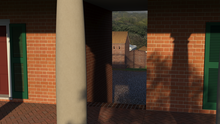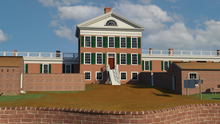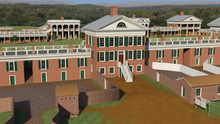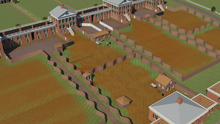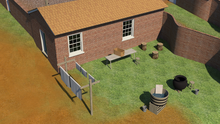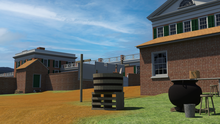The decision to begin construction on Pavilion VI was made by Thomas Jefferson and John H. Cocke in the summer of 1819 without approval from the Board of Visitors, which was between meetings; construction was retroactively approved in the fall of 1819. In order to keep the University's construction moving forward, Jefferson and Cocke made the decision to start Pavilion VI when Joseph Cabell, who was on the Board of Visitors, disagreed with Jefferson's design scheme for the hotels. Pavilion VI was the first building to be started on the East Lawn. Construction was substantially complete by 1822, with finishing touches completed as late as 1824. The design of the pavilion is based on plates of the Ionic Theater of Marcellus from either Palladio or Chambray.
Thomas Hewitt Key, professor of mathematics, navigation, architecture, and astronomy, was the first to occupy Pavilion VI, beginning in 1824. The first alterations at the pavilion were made by the second tenant, Gessner Harrison, who lived there from 1828 to 1835. In 1831, Harrison submitted plans to the Board of Visitors for the construction of an office; while no evidence survives, this may have been a one story basement-level addition for housing servants with a porch above. In the summer of 1834, Harrison was reimbursed for "opening a window at his pavilion.”[1] Sometime between 1860 and 1875, a two story addition and porch were constructed on the rear of Pavilion VI- this occurred during either the occupation of Lewis M. Coleman or George F. Holmes. Through the end of the 19th century, small improvements were made as indoor plumbing and gas came to the University. In 1928, under Superintendent of Buildings and Grounds William A. Lambeth, Pavilion VI was converted from a faculty residence into the Romance Pavilion, where French, Spanish, and Italian were taught. Pavilion VI was converted back into a residence in 1954.
See also: Pavilion VI Animation, Pavilion VI Garden Then and Now Animation, and Pavilion VI Photograph Gallery
[1] Board of Visitor Minutes, July 18, 1834
|
Pavilion VI west facade from northwest |
Pavilion VI west facade |
Pavilion VI student roof |
|
Pavilion VI colonnade from Lawn |
Pavilion VI colonnade looking north |
Pavilion VI view to alley |
|
Pavilion VI rear facade close-up |
Pavilion VI rear facade |
Pavilion VI with garden |
|
Pavilion VI aerial view of workyard |
Pavilion VI workyard near Structure 1 |
